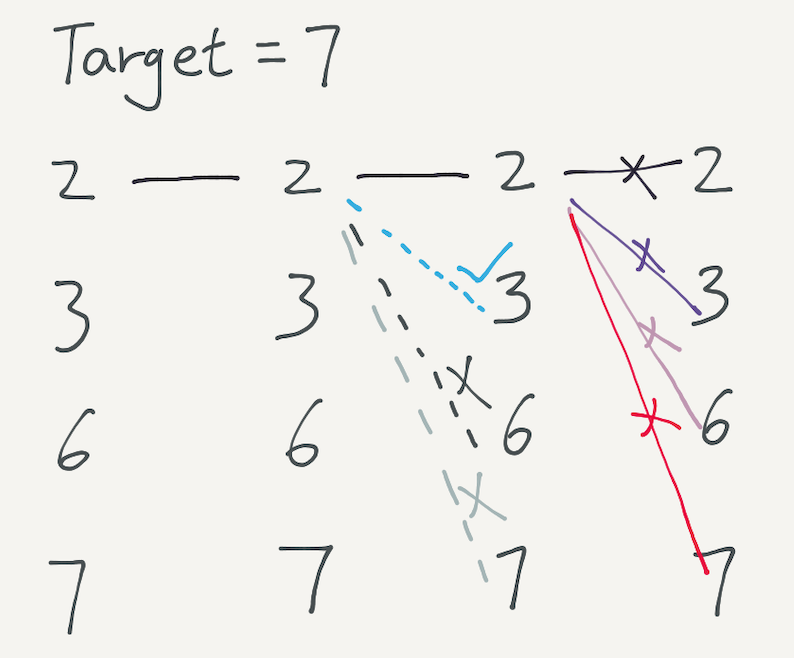Given a set of candidate numbers (C) and a target number (T), find all unique combinations in C where the candidate numbers sums to T. The same repeated number may be chosen from C unlimited number of times.
Note: All numbers (including target) will be positive integers. Elements in a combination (a1, a2, … , ak) must be in non-descending order. (ie, a1 <= a2 <= ... <= ak). The solution set must not contain duplicate combinations. For example, given candidate set 2,3,6,7 and target 7, A solution set is:
[7] [2, 2, 3]
Java Solution
The first impression of this problem should be depth-first search(DFS). To solve DFS problem, recursion is a normal implementation.
The following example shows how DFS works:

public List<List<Integer>> combinationSum(int[] candidates, int target) { List<List<Integer>> result = new ArrayList<>(); List<Integer> temp = new ArrayList<>(); helper(candidates, 0, target, 0, temp, result); return result; } private void helper(int[] candidates, int start, int target, int sum, List<Integer> list, List<List<Integer>> result){ if(sum>target){ return; } if(sum==target){ result.add(new ArrayList<>(list)); return; } for(int i=start; i<candidates.length; i++){ list.add(candidates[i]); helper(candidates, i, target, sum+candidates[i], list, result); list.remove(list.size()-1); } } |
Hi Guys
I made a small video explaining the recursion and backtracking concept. Please check out the video
https://www.youtube.com/watch?v=fL0uPiNHGnw
I think the solution would break on [2,2], 4
The result will have several lists with the same elements – [2,2] – breaks the instruction of “The solution set must not contain duplicate combinations”.
Just add this line in place of if(target==0),
(target==0 && result.contains(curr))
This solution doesn’t handle duplicate numbers in the list. Duplicates should be stripped out or logic needs to account for it.
What would be the running time of this algorithm?
Because this is the main idea of backtracking – try option (curr.add(candidate)), then backtrack – curr.remove(cur.size()-1)
This solution is incorrect. If candidates are [2, 3, 3, 6, 7]. The returned lists would be:
[2, 2, 3]
[2, 2, 3]
[7]
May need to add some condition to exclude the repeated entry in candidates.
Why can’t we just add curr to result ? Why do we use temp ?
I don’t think so, because duplicates are allowed in a combination set, i. e., the same number csn be used twice.
Shouldn’t it be i+1, 3rd parameter here->combinationSum(candidates, target – candidates[i], i, curr, result);
Great solution. why are we removing the last element from curr. (last line where curr.remove(curr.size()-1) ? )
public static void sum(int[] set,int s){
int [][]dp = new int[s+1][set.length];
for(int i=0;i < set.length; i++){
for(int j = 0; j j){
dp[j][i] = 0;
continue;
}
if(set[i] == j){
dp[j][i] = i+1;
continue;
}
int remaining = j-set[i];
int k = i;
while(k >= 0){
if(dp[remaining][k] > 0){
dp[j][i] = k+1;
break;
}
k–;
}
}
}
int l=0;
while(l 0){
int sum = s;
int col = l;
System.out.print(“[“);
while(sum > 0){
System.out.print(set[col]+”,”);
int temp = col;
col = dp[sum][col]-1;
sum -= set[temp];
}
System.out.print(“]”);
}
l++;
System.out.println(“”);
}
}
Java always pass parameters by value. Here curr is a refferrece to the array object, if you don’t copy it but add it to the result directly, later when you modify curr, it will change the list inside result. You may end up with all same lists in result. You can self-test it.
I wonder why we need make a temp ArrayList and then copy the curr Arraylist and then add temp into result, why just add curr into the result directly?